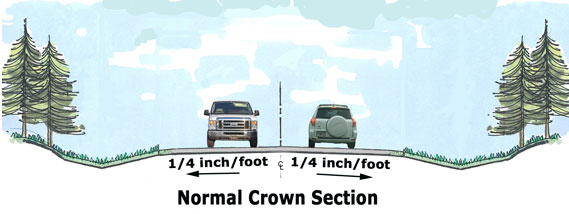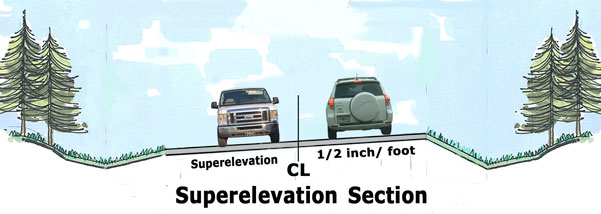For service in the Atlanta, Georgia area contact or call us:
Hydroplaning in Curve Transitions
Hydroplaning in Curve Transitions
Hydroplaning in curve transitions can happen in the area where the positive cross slope changes to a negative cross slope. Roadways have horizontal curves to create a smooth ride through a curve. Roadways are banked much like a race track in the curve...but not as much. It is easier and smoother for drivers to steer through a curve when the roadway is superelevated.

Normal Crown Sections
Roadways are designed to have normal crown sections in the straight sections of the roadway. Engineers refer to straight sections as tangent sections. The roadway is usually crowned in the middle of the roadway. See the two-lane illustration above. The high point in the pavement is at the center line of the highway.
Crowns are built into the roadway pavement to allow stormwater to run off the pavement and into the ditches along the side of the roadway. This prevent water from sitting on the pavement and causing cars to hydroplane.
Superelevated Sections
Horizontal curves are superelevated for safety. The high point in the pavement is the outside of the curve. The inside of the curve is lower. This serves two purposes. First to remove the water from the pavement surface and to provide a smooth ride through the curve.
Hydroplaning in curve transitions rarely occur when tangent sections and superelevation sections are well maintained. Water is efficiently removed from the pavement surface and vehicle tires maintain contact with the surface of the pavement.
The superelevation section shown in the illustration shows how the pavement is higher on the right side of the illustration. So water would travel from the right side of the roadway to the left side of the roadway.

Transition from Superelevaton
to Normal Section
As you travel out of a superelevated curve section into a straight section, the roadway pavement must transition back to a normal section. We noted that the right side of the pavement is higher in the superelevation.
Over a distance along the roadway, the right side of the pavement must begin to drop in elevation in relation to the center line until the crown is in the middle of the lanes.This is the transition from a superelevtion section to a normal crown section.
As this transition is occurring, at a point the right lane (the outside lane) will be level. The transition should continue until the right outside edge of the pavement is at the same elevation as the left outside edge of pavement...leaving a crown in the middle of the pavement.
A normal section will be higher in the middle than each edge of pavement. It is the transition that can cause problems with drainage, i.e. hydroplaning in curve transitions. They are often the cause of hydroplaning accidents.
In cases where the distance of the curve transition is flat will result in water staying on the roadway pavement. When water stays on the pavement, it get deeper and deeper.
Vehicle experience a side force while negotiating a horizontal curve. Combine the horizontal curve transition with a longer path of water and a greater depth of water and you have the conditions for hydroplaning.
Hydroplaning Vehicles
I have investigated many accident scenes and found the transition was not uniform. I found one highway maintained a 0 percent cross slope for 300 feet. During a heavy rain storm, the driver attempted to steer right to negotiate the curve, encountered water standing on the pavement surface and hydroplaned. Her vehicle left the roadway and hit large trees along the side of the highway.
She experienced hydroplaning in curve transitions... going from a superelevation to a tangent section and the pavement holding water because it was level. It did not transition as designed.
Hydroplaning Accidents
I have worked many cases where the transition was not maintained correctly. Highways are overlaid with asphalt many times during the life of a roadway. The pavement surface gets worn or the asphalt pavement structural strength deteriorates due to heavy wear.
So the Department lets a contract to overlay the existing pavement. Rarely have I seen detail specifications of how the contractor should pave in transitions.
Hydroplaning in curve transitions is dangerous and often the cause of accidents. That is teh reason that this is one of the first factors I look for at the scene where a hydroplaning accident occurred.
Elvin Aycock PE, PH, PLS
I specialize in hydroplaning accidents. There are 4 forensic parts to a hydroplaning accident case. They are:
- Roadway: PE, Professional Engineer needed to understand roadways.
- Water: PH, Professional Hydrologist to study the movement of water on pavement surface.
- Surveying: PLS, Professional Land Surveyor to obtain and understand the roadway data from a survey.
- The Accident: ACTAR, Accident Certification to reconstruct the accident.
Further Reading About Hydroplaning
Hydroplaning caused by roadway defects
Qualifications of a good hydroplaning expert
Hydroplaning article written by Elvin Aycock for the American Institute of Hydrology.
Home Page - Atlanta Engineering Services
Ruts cause hydroplaning where the asphalt and the subgrade has failed.
Hydroplaning on roadways while transiting from superelevation to normal crown
Pavement drainage can be a problem in vertical curve sags and in transitions from superelevations to tangent sections.
More pavement drainage problems occur when the centerline crown is destroyed and superelevation transitions hold water.
